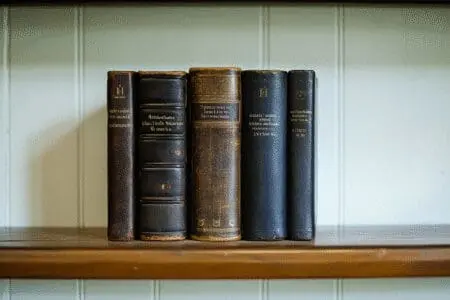Did you know that over 80% of American households own a Bible? Yet, a much smaller number of people actually read it regularly. For years, my own Bible was one of them. It sat on my nightstand, looking important and collecting dust. It felt like a giant, intimidating book filled with ancient rules and stories I couldn’t connect with. I wanted to understand it. I truly did. But I had no idea where to even start. If that sounds like you, take a deep breath. You are in the right place. This guide is for you. We’re going to break down exactly how to read the Bible for beginners in a way that feels simple, personal, and genuinely life-changing.
This isn’t about becoming a scholar overnight. It’s about starting a conversation with God.
More in Bible Category
What Bible Should I Read as a Beginner
Key Takeaways for Your Journey
- Don’t Start at the Beginning: Please don’t start with Genesis. You’ll likely get bogged down. Start with the Gospels, like the book of John or Mark, to learn about Jesus first.
- Choose an Easy-to-Read Translation: The Bible you actually read is the best one. Try the New International Version (NIV) or the New Living Translation (NLT) for modern, clear language.
- Consistency Beats Quantity: Five meaningful minutes a day is far better than two stressful hours once a month. Build a small, daily habit.
- Pray Before You Read: A simple prayer asking God to speak to you can change everything. It shifts your mindset from “studying a text” to “listening to a person.”
- Look for Application: Always ask, “What does this mean for me today?” The Bible is meant to be lived, not just learned.
Why Does the Bible Feel So Hard to Read at First?
Let’s just be honest. The Bible can feel overwhelming. It’s not one book; it’s a library of 66 books. These were written over thousands of years by different authors in different cultures.
So, of course it feels a little strange at first.
You have poetry, history, letters, and prophecies all in one place. No other book is like it. The pressure we put on ourselves doesn’t help either. We feel like we have to understand every single word perfectly. We worry we’ll get it wrong.
That fear can keep us from starting at all. But I want to tell you something important. It’s okay to have questions. It’s okay to be confused sometimes. Every single person who reads the Bible feels that way. The goal is progress, not perfection.
What Is the Most Important Mindset Before I Start Reading?
Before you even pick a translation or a reading plan, your heart posture matters most. Getting this right will change your entire experience.
You Are Building a Relationship, Not Just Learning Rules
The biggest mistake people make is seeing the Bible as an instruction manual. Or a history textbook. Or a list of dos and don’ts.
While it contains all of those things, it’s so much more.
The Bible is a story. It’s God’s grand rescue story for humanity. It shows us His character, His love, and His plan to bring us back to Him. At the center of that story is a person: Jesus Christ.
When you open the Bible, you are opening a letter from someone who loves you deeply. You are getting to know the God of the universe. See it as a conversation. He speaks to you through the words, and you can speak back to Him through prayer. This isn’t about checking a box on your religious to-do list. It’s about connection.
How Should I Pray Before Reading the Bible?
Prayer softens our hearts to what God wants to say. It is an act of humility. It admits we don’t have all the answers. And it invites the Holy Spirit to be our teacher.
Your prayer doesn’t need to be long or formal.
Just be sincere. Here are a few simple examples:
- “God, thank you for your Word. Please open my eyes to see what you want to show me today. Help me understand it and apply it to my life. Amen.”
- “Jesus, I want to know you better. Speak to me through this passage. Amen.”
- “Holy Spirit, be my guide as I read. Give me wisdom and clarity. Amen.”
Starting with a short prayer like this can make a world of difference. It turns reading into a spiritual experience.
What Are the Best Bible Tools for a Beginner?
Okay, now for the practical stuff. You don’t need a seminary degree, but having the right tools can make your reading much smoother and more enjoyable.
Which Bible Translation Should I Actually Use?
Walking into a Christian bookstore can be confusing. There are dozens of Bible translations. Why so many? Because translating ancient Hebrew and Greek into modern English is complex. Some translators focus on being very literal, or “word-for-word.” Others focus on capturing the original “thought-for-thought.”
For a beginner, a thought-for-thought translation is usually best. It’s easier to read and understand.
Here Are a Few Great Translations for Beginners
- New International Version (NIV): This is the most popular English translation for a reason. It finds a great balance between being accurate to the original text and being very readable. It sounds like clear, modern English.
- New Living Translation (NLT): This one is even more conversational. It reads almost like a novel. The NLT is fantastic for getting the big picture of a story and understanding the emotional heart of a passage.
- English Standard Version (ESV): The ESV is a bit more word-for-word than the NIV but is still very readable. Many people love its beautiful and powerful language. It’s great for more in-depth study once you get comfortable.
A quick note: You might have a King James Version (KJV) at home. The KJV is beautiful and historic, but its old English (“thee,” “thou,” “verily”) can be very difficult for a new reader. I’d suggest setting it aside for now and starting with one of the modern versions above.
Where in the World Should a Beginner Start Reading the Bible?
Your first instinct might be to open to page one, Genesis 1:1, and start reading. I strongly advise you not to do this. The Old Testament is incredibly important, but books like Leviticus and Numbers can be dense and confusing for someone just starting out. You might get discouraged and quit.
Instead, start with the person of Jesus.
Here Are the Best Books for a Beginner to Start With
- The Gospel of John: This book was written so that you may believe that Jesus is the Christ, the Son of God. It focuses on who Jesus is, His miracles, and His deep love for people. It’s a perfect starting point.
- The Gospel of Mark: This is the shortest and most action-packed Gospel. It moves quickly through Jesus’s life, ministry, death, and resurrection. It’s like a spiritual shot of espresso.
- Psalms: This is the Bible’s songbook and prayer journal. The Psalms cover the full range of human emotions, from joy and praise to anger and despair. You will find your own feelings reflected in these pages. You can just open it to any chapter and read.
- Proverbs: This book is full of short, wise sayings about everyday life. It offers practical wisdom on topics like money, relationships, and hard work. It’s easy to read one chapter a day.
- The Book of James: This is a very practical book. James gets straight to the point about how to live out your faith. He talks about controlling your tongue, caring for the poor, and having faith that works.
Starting with these books will give you a solid foundation. You’ll learn about Jesus and get practical wisdom for your life right away.
Can You Give Me a Simple, Step-by-Step Reading Method?
So you’ve got your Bible and you’ve picked a book to read. Now what? How do you actually pull meaning from the text?
Having a simple method can help you engage with the scripture. Here is an easy four-step process you can use every time you read.
Step 1: Pray
We already covered this, but it’s always the first step. Ask God to guide your reading time.
Step 2: Observe – What Does the Passage Say?
This step is about slowing down and paying attention. Don’t try to find deep hidden meanings yet. Just look at what is right there in the text. Read the passage once or twice.
Then, ask some simple questions:
- Who wrote this? Who were they talking to?
- Are there any key people or places mentioned?
- What is the main event or idea in this section?
- Are there any words or phrases that are repeated?
- What is the general mood (happy, sad, urgent)?
This is like looking at the puzzle pieces before you start putting them together. You’re just taking inventory of what’s there.
Step 3: Interpret – What Does the Passage Mean?
Now you can dig a little deeper. You’re trying to understand what the author originally meant. Context is everything here. A verse can mean something completely different if you take it out of its chapter.
Ask these questions:
- What was the main point the author was trying to make to his original audience?
- How does this fit into the story of the chapter and the book as a whole?
- How does this passage teach me something about God’s character?
- How does this passage point to Jesus? (Even in the Old Testament, there are shadows and promises of Him).
It’s in this step that outside resources can be helpful. A good study Bible will have notes at the bottom of the page that explain cultural context. You can also find great, reliable resources online. For instance, universities like Biola University offer guidance on how to study the Bible, which can help you understand these interpretive principles better.
Step 4: Apply – What Does This Passage Mean for Me?
This is where the Bible moves from being information to transformation. This final step is the most personal. You are asking how the truth of this passage should change your life today.
Ask yourself:
- Is there a command for me to obey?
- Is there a promise for me to claim?
- Is there an example for me to follow (or avoid)?
- Does this change how I see God?
- Does this change how I see myself or others?
- What is one specific thing I can do, think, or say differently today because of what I just read?
Answering this last question is key. It moves you from being a hearer of the word to a doer.
How Can I Stay Consistent With Bible Reading?
Starting is one thing. Sticking with it is another. Life gets busy. You might miss a day or two. You might read a passage that feels boring or confusing. It’s completely normal. Here’s how to build a lasting habit.
What Do I Do When I Get Bored or Confused?
First, give yourself grace. Don’t let guilt make you quit. Just pick it back up the next day. Even a little bit is better than nothing.
Second, use a reading plan. This is one of the best ways to stay on track. A reading plan tells you exactly what to read each day. It removes the decision fatigue. There are thousands of plans available.
- Bible Apps: Apps like YouVersion are amazing for this. They have plans on every topic imaginable, from anxiety to leadership. They last anywhere from three days to a whole year.
- Online Plans: Many websites offer printable reading plans that guide you through a book or the entire Bible.
Is It Better to Read the Bible Alone or With Others?
You can absolutely read the Bible on your own. Personal devotion time is powerful. But reading it with other people can open up a whole new dimension.
When you discuss a passage with a friend or a small group, you get to hear their perspective. They might see something you missed. You can ask questions in a safe place. You can also encourage each other and hold each other accountable.
If your church has small groups, join one. If not, just ask a friend if they want to read a book of the Bible with you. You can meet for coffee once a week to talk about it. Community makes the journey so much richer.
A Final Word of Encouragement
Reading the Bible is a journey, not a destination. It’s a marathon, not a sprint. Some days the pages will feel alive and speak directly to your heart. Other days you might just read and not feel much at all. That’s okay.
The important thing is to show up.
God honors your desire to know Him. He’s not waiting for you to have it all figured out. He is patient and kind. He will meet you right where you are.
So lose the fear. Let go of the pressure. Grab a readable translation, say a simple prayer, and open to the book of John. Discover the story of a God who loves you more than you can imagine. He is waiting for you in those pages. You can do this.
Frequently Asked Questions – How to Read the Bible for Beginners

How should I approach reading challenging or violent stories in the Bible?
When encountering harsh stories, it is important to view the Bible as a historical document, consider the larger context, including the character of God as revealed through Jesus, and remember that some passages reflect ancient customs that are different from today.
What tools can help me understand the Bible better as a beginner?
Using a good translation like the NIV or NLT, keeping a notebook to jot down questions and notes, and utilizing apps like the YouVersion Bible App or watching explanatory videos from resources like The Bible Project can enhance your reading experience.
What should I do if I find parts of the Bible confusing or difficult?
Feeling confused is normal. When difficult passages arise, try to see the bigger picture, remember the historical context, or set the passage aside temporarily and revisit it later as your understanding grows. Asking trusted people or using helpful resources like the Bible Project can also aid your comprehension.
How can I develop a consistent habit of reading the Bible?
To build a habit, set a specific time and place for reading each day, start with a manageable amount of time like 5-10 minutes, and consider finding a friend to read with for motivation and accountability.
What is the best way for a beginner to start reading the Bible?
A good way for beginners to start reading the Bible is to begin with the Gospels, such as the Gospel of John or Mark, because they introduce the story of Jesus and connect the Old and New Testaments. Starting with simpler, story-driven books helps to build understanding gradually.




